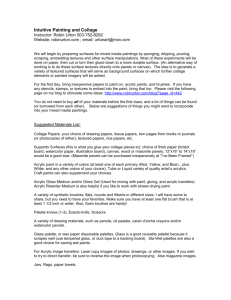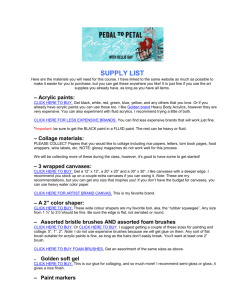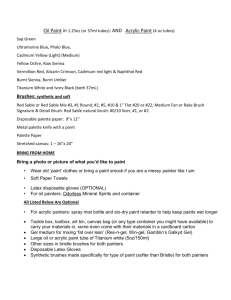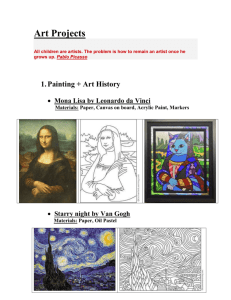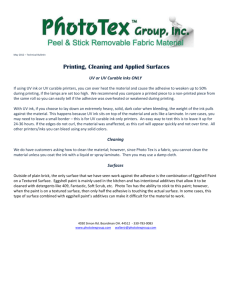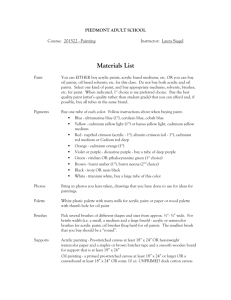Art 222 Syllabus
advertisement
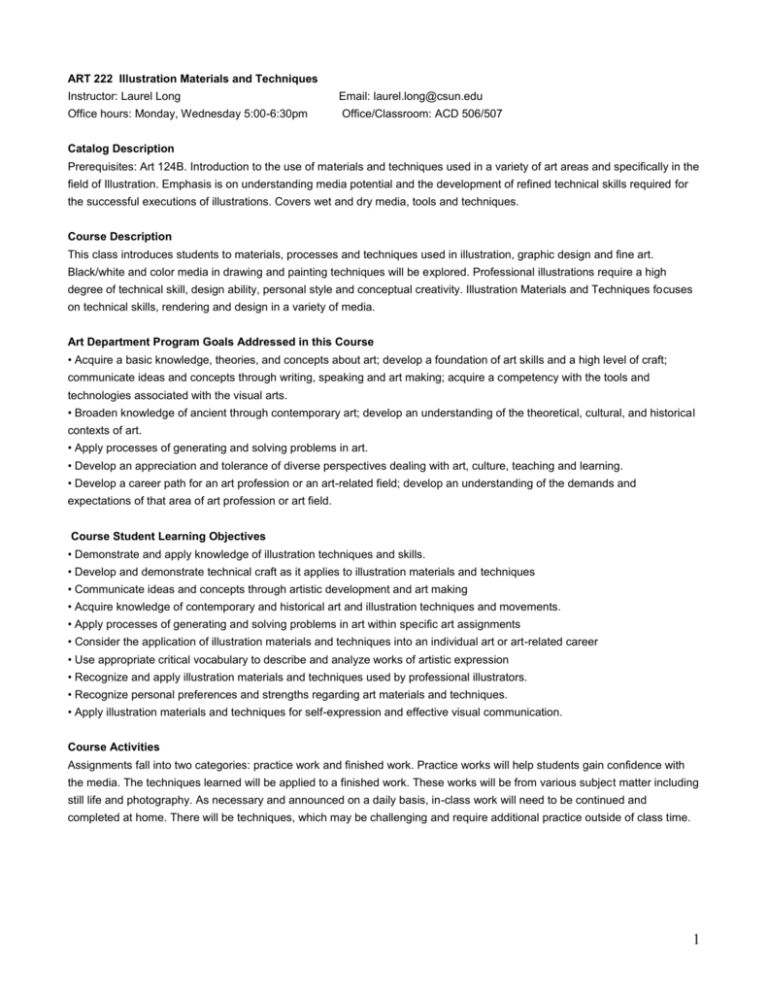
ART 222 Illustration Materials and Techniques Instructor: Laurel Long Email: laurel.long@csun.edu Office hours: Monday, Wednesday 5:00-6:30pm Office/Classroom: ACD 506/507 Catalog Description Prerequisites: Art 124B. Introduction to the use of materials and techniques used in a variety of art areas and specifically in the field of Illustration. Emphasis is on understanding media potential and the development of refined technical skills required for the successful executions of illustrations. Covers wet and dry media, tools and techniques. Course Description This class introduces students to materials, processes and techniques used in illustration, graphic design and fine art. Black/white and color media in drawing and painting techniques will be explored. Professional illustrations require a high degree of technical skill, design ability, personal style and conceptual creativity. Illustration Materials and Techniques focuses on technical skills, rendering and design in a variety of media. Art Department Program Goals Addressed in this Course • Acquire a basic knowledge, theories, and concepts about art; develop a foundation of art skills and a high level of craft; communicate ideas and concepts through writing, speaking and art making; acquire a competency with the tools and technologies associated with the visual arts. • Broaden knowledge of ancient through contemporary art; develop an understanding of the theoretical, cultural, and historical contexts of art. • Apply processes of generating and solving problems in art. • Develop an appreciation and tolerance of diverse perspectives dealing with art, culture, teaching and learning. • Develop a career path for an art profession or an art-related field; develop an understanding of the demands and expectations of that area of art profession or art field. Course Student Learning Objectives • Demonstrate and apply knowledge of illustration techniques and skills. • Develop and demonstrate technical craft as it applies to illustration materials and techniques • Communicate ideas and concepts through artistic development and art making • Acquire knowledge of contemporary and historical art and illustration techniques and movements. • Apply processes of generating and solving problems in art within specific art assignments • Consider the application of illustration materials and techniques into an individual art or art-related career • Use appropriate critical vocabulary to describe and analyze works of artistic expression • Recognize and apply illustration materials and techniques used by professional illustrators. • Recognize personal preferences and strengths regarding art materials and techniques. • Apply illustration materials and techniques for self-expression and effective visual communication. Course Activities Assignments fall into two categories: practice work and finished work. Practice works will help students gain confidence with the media. The techniques learned will be applied to a finished work. These works will be from various subject matter including still life and photography. As necessary and announced on a daily basis, in-class work will need to be continued and completed at home. There will be techniques, which may be challenging and require additional practice outside of class time. 1 Academic Dishonesty Academic dishonesty is a serious offense for which a student may be expelled, suspended or awarded a failing grade to an assignment or the entire course. Academic dishonesty includes cheating, fabrication, facilitating academic dishonesty and plagiarism. A student found to be committing academic dishonesty will be reported to the Office of the Vice President for Student Affairs. The student code of conduct is on page 586 of the University Catalog or on the CSUN website:http://www.csun.edu/studentaffairs/pdfs/standards_student_conduct.pdf. Student Conduct Code Students are expected to "act at all times with integrity and with respect toward all members of the campus community. The University assumes that all students will conduct themselves as mature, responsible, and law-abiding citizens who will comply with University policies and regulations." See the current University catalog. Classroom rules • Cell phones must be turned off or put on vibrate. Phone talking or texting in class is not allowed. • No headphones. • No laptop use during lectures. Using your laptop to work on anything outside of this course during class time is not permitted. Violations will affect your final grade. • You are welcome to bring food and drinks into class. However make sure that all drink containers have a tight fitting, spill proof lid. Keep all food items and drinks away from art work at all times. Missed Class Policy Lectures and demos cannot be repeated. Contact a classmate for missed information. Name_____________________________________Contact info _____________________________________ Attendance Policy Attendance is required. The following will be applied in determining the final grade in the course. • Three absences are allowed without penalty. More than three absences will result in a lower final course grade • Save your three absences for emergencies or illness. • A doctor’s note will not excuse absences beyond the three allowed. If illness requires more than three absences, a medical withdrawal from the course is recommended. • Roll is taken every class. Three late arrivals and/or early departures will be counted as one absence. • You may ask at any time for your attendance and grade information. Grading Final Grading is based on: Projects grades, effort and attendance (see above). • Projects are graded on the basis of demonstrated knowledge of course content, effective and ambitious solutions to problems, technique and presentation • Projects and exercises not completed on deadline will not be accepted. • Unpreparedness and projects not worked on during class time will lower the final project grade. • Assignments that have met the deadline requirements can be revised and resubmitted for a higher grade. To earn an A or A- you must do the following: • Earn an overall grade of at least an A- on the assignments • Meet all deadlines • Have no more than three absences • Be on time to class and do not leave class early (unless emergency) • Have the necessary supplies to work in class • Take notes and/or sketch lecture material • Demonstrate a commitment to the subject and be involved in class. 2 Grade Point Scale Grading is in accordance with university policy: A, A-, B+, B, B-, C+, C, C-, D+, D, D-, and F A= outstanding, B= good, C= average, D= unsatisfactory, F= failure A = 95 – 100, A- = 90 – 94, B+ = 87 – 89, B = 83 – 86, B- = 80 – 82, C = 73 – 76, C+ = 77 – 79 C- = 70 – 72, D+ = 67 – 69, D = 63 – 66, D- = 60 – 62, F = 0 – Supplies Continental Art Supply (7041 Reseda Blvd, 818-345-1044) has all the supplies you need. If you shop there, tell them you are in Laurel Long’s Art 222 class and they will know exactly what you need. Many of the supplies can also be purchased at Michael’s. Register online or download Michael’s app to receive 20-50% off weekly coupons. Do not buy new supplies if you already have supplies from other classes. If you are not sure about supplies please ask me. Surfaces • One 20x30” Strathmore 500 Series Heavyweight Illustration Board, cold pressed cut into six 10 x 10” pieces. ($10.99 per 20 x 30 “ board- available at Continental Art Supply, some Michael’s) • Two 8 x 10” stretched canvases • One 11x14” Strathmore Vellum Bristol pad or Mixed Media pad Paint Media -Watercolors: inexpensive pan or tube set -Oil paints: Gamblin Art Sketching Oils, Grumbacher Academy or Van Gogh are recommended -Acrylic paints: Golden Heavy Body Matte, Liquitex Heavy Body, or Holbein Acryla Gouache are recommended (if you already have student grade acrylics, get an artist grade acrylic titanium white) -Colors for both oil and acrylic paints: • Alizarin crimson • Cadmium red light (any warm red) • Cadmium yellow medium (any warm yellow) • Ultramarine blue • Pthalo blue • Titanium white • Burnt umber - Folk Art, Americana or Craft Smart Acrylic paint (Michael’s)- 2 mat, opaque colors, a dark and a light -Small gesso Brushes • Soft brushes only, Simply Simmons Studio white nylon acrylic and oil 6 brush set E or Artist Loft Necessities white or golden 10 brush set recommended • One medium eye shadow brush: Target up & up brand ($2.49) • 1 or 1 ½” hardware store bristle brush Drawing Media • Waterproof black India ink (Winsor Newton, Sumi or Bombay) • Pens: individual or sets (Sakura Pigma Micron or Artist Loft illustration pen or Prismacolor Premier illustration pen- 005, 01, 03, 05, or Staedtler Pigment Liner .1-.7mm) • Optional: Ballpoint pen- (Staedtler 924 or Pilot G tech C3), #104 fine point dip pen •.5mm mechanical pencil (H) 3 Other Supplies • Disposable poly-coated palette pad: 9 x 12 inches • Calque CansonTracing paper pad 9 x 12 “ • Sandpaper 100, 320 grit • #11 x-acto blade with replacement blades • 2-3 small plastic or glass containers • Magic tape, drafting tape • Small spray bottle • Natural sponge • Small linseed oil • Small desk lamp • Small T-square • 10” triangle • Metal not plastic palette knife: Michael’s- Artist Loft, Trowel #102 Art Supply Stores (take student ID as most stores give student discounts) Carter Sexton M–F 9–6 Continental Art Store M–F 10 – 7 5308 Laurel Cyn. Blvd. Sat 9 – 5:30 7041 Reseda Blvd. Sat 10 – 6 N. Hollywood Reseda 818-763-5050 818-345-1044 Dick Blick M-F 9–8 Pearl Art Supplies Inc. M–S 9:30 - 8:30 44 S. Raymond Ave. Sat 9–7 1250 S. La Cienega Blvd. Sun 11 – 6 Pasadena Sun 10 – 6 Los Angeles Utrecht Art Supply M–S 9–8 San Clemente Art Supply M–F 10 – 6 11677 Santa Monica Bl. Sun 10 – 7 1531 N. El Camino Real W 10 – 7 San Clemente Sat 10 – 6 626-795-4985 310-854-4900 Los Angeles 310-478-5775 949-369-6603 Swain’s M-F 9–7 M – Sat 10 - 8 537 N. Glendale Ave. Sat 9 - 5:30 1718 N. Vermont Ave. Glendale Sun 10 - 5 Los Angeles, CA 90027 Blue Rooster Art Supplies 818-243-3129 Sun 10 - 7 323-661-9471 There are several good catalog art supply companies. www.danielsmith.com www.aswexpress.com www.jerrysartarama.com www.DickBlick.com www.UtrechtArt.com www.RexArt.com www.cheapjoes.com Assignments: Subject Matter Use still life objects and/or your own photographs when possible. A desk lamp will be needed for still life objects. Photographs must have clear and defined focus, detail and lighting. If you use public domain digital images of your subject, you must draw from a variety of images of your subject. Consider nature subjects or man made subjects for example: Plants Rodent Vegetables Insects Architecture Machinery Shells Fruit Birds Anatomy Flowers Human face Animals Marine life Reptiles Assignments: Format 1/2" minimum margins- Do not draw or paint up to the trim edges of the illustration board. Both sides of the Strathmore 500 Series Heavyweight Illustration Board can used. Canvases can be painted to edges. Presentation Clean, squarely cut board flapped with tracing paper that is neatly taped with magic tape and trimmed to board size. Continental will cut the illustration board for you. 4 Assignments 1. Ink: Realism -Media/Tools: fine tip ink pen, ballpoint pen or fine point dip pen, Bristol pad, tracing paper, lamp -Techniques: hatching, crosshatching, stippling, transferring -Your drawing must have convincing value gradations, textures, three-dimensional rendering and clarity. - Subject: with texture and mass from still life reference Assignment: Draw a lit still life object that has texture and mass (garlic, onion, artichoke, asparagus, mushroom, egg, flower etc.) in fully rendered realism Exercises: 1. Practice drawing a variety of small lines: straight, curved, scribble etc. Draw quickly and lightly. Use the pen like a brush. Do not press hard. Lift up on the pen so that the lines taper away at the end. 2. Crosshatch a full value range gradation in a 2x4” box 3. Contour hatch a 2x3” cylinder using small straight or curved lines. 4. Draw a 2 ½” sphere. Include highlight, ¼ tone, ½ tone, core shadow, reflected light and cast shadow. 5. Draw a feather from photo reference, work out technique on tracing paper over photo - Research artists: Ben Tolman, Jack Unruh, Edel Rodriguez, Alan E. Cober, Lars Henkel, Bagram Ibatoulline, Peter Sis, Murray Tinkelman, Henrik Drescher, Geoffrey Moss, Edward Gorey, James Jean, Rembrandt, Albrecht Durer, Van Gogh, Da Vinci, Michaelangelo, Thomas Nast, Sir John Tenniel, Gustave Dore, Aubrey Beardsley, Henry Ford __________________________________________________________________________________ 2. Ink: Graphic -Media/Tools: ink pens, small round brush, ink, Bristol board, tracing paper -Techniques: designing, drawing graphic lines, patterns and shapes to create textures and volume -Your drawing must have a graphic quality -Subject: with texture and mass from photo reference Assignment: Draw in ink on tracing paper over your photo subject to work out the design of the lines, textures, patterns and shapes. Transfer your design to Bristol paper. Draw the subject graphically in ink. Exercises: 1. Using brushes and ink draw a variety of lines: thick to thin, flowing, angular etc. 2. Draw in pen on tracing paper over your feather photo. Work out the design of the lines and shapes. 3. Draw with a small round brush on tracing paper over your feather photo 4. Draw with a small round brush on tracing paper over your four photos of faces - Research artists: Jeffrey Decoster, Aaron Horkey, Cathie Bleck, Melinda Beck, Edel Rodriguez, Yuko Shimizu, David Hughes, Marcos Chin, Fernanda Cohen, Jillian Tamaki, Josh Cochran, Andy Friedman, Philip Burke, Jeffrey Fisher, John Hendrix, Dushan Milic, Kako, Kagan McLeod, Dominic Bugatto, Jared Purrington, Michael Sloan, Mark Todd, Ward Schumaker, Karen Davison, Patrick Arrasmith, Scott McKowen, Nate Williams, Aaron Hogg, James Jean __________________________________________________________________________________ 5 3. Ink: Expressive -Media/Tools: ink, pens, brushes, straw, illustration board -Techniques: line variety: thick, thin, flowing, angular, straight, curved lines, splatter, washes, spray, hatching, crosshatching, stippling-optional) -Your drawing must have a dynamic and expressive quality -Subject: with texture and mass from photo or still life reference Assignment: Draw the subject with expressive, dynamic elements using ink techniques. 9x9” max image Exercises: 1. Practice: using pens, brushes and straw, draw and paint a variety of lines, brushstrokes and shapes: thick, thin, flowing, angular, organic, straight and curved, splatter 2. Paint eight values from dark to light using in ink washes 3. Draw your feather photo using pens, brushstrokes and washes -Research: View the websites of the following artists: Ralph Steadman, Jonathon Wayshack, Joe Morse ____________________________________________________________________________________ 4. Ink and Color Washes -Media/Tools: ink, pens, brushes, watercolor paint, illustration board, palette -Techniques: watercolor washes, ink drawing -Subject: A lit still life object or photo reference Assignment: Draw the subject using any of the ink techniques from assignments 1-3 and color washes. The painting and ink drawing can overlap but do not have to align, or they align to create 3D volumes and textures, 9x9” max image Exercises: 1.Gradated wash dark to light – wet on dry 2.Gradated wash dark to light – wet on wet, clear water first 3.Layer two primaries to create secondaries– wet on dry 4.Layer primaries and secondaries to create tertiaries– wet on dry 5.Layer complementaries to create neutrals– wet on dry Research: Bagram Ibatoulline , Cathie Bleck, Jack Unruh, Fernanda Cohen, Ralph Steadman, Sam Weber, Jillian Tamaki, Henrik Drescher, Joe Ciardiello, Andy Friedman, Philip Burke, Jeffrey Fisher, John Hendrix, Lars Henkel, Dushan Milic, Dominic Bugatto, Jared Purrington, Michael Sloan, Peter Sis, Edmund Dulac. Arthur Rackham, Beatrix Potter ____________________________________________________________________________________ 6 5. Acrylic Backgrounds -Media/Tools: acrylic paint, craft paint, gesso, brushes, hardware store bristle brush, sandpaper, sponge, palette, palette knife -Techniques: dry brushing, creating surface texture, layering, sponging, sanding Assignment: Tape edges of 4x4” square, gesso each square 1. Paint entire box with gesso to create a textured surface, let dry. Paint dark color first, let dry, dry brush a slightly lighter color, let dry, repeat layers with increasingly lighter colors to create a gradation 2. Paint dark color, let dry, dry brush light color over with bristle brush, apply wet paint, slant/drip 3. Mix 5 values of a color, paint half of the box with the light color, let dry, paint overlapping shapes and lines in the next value, let dry, repeat layers brush. Repeat in other half of box reverse the value sequence. 4. Use sponge to apply paint in layers of colors that have similar value Research: Jason Holley, Camille Rose Garcia, Nathan Ota, Clayton Bros., Olaf Hajek, Genevieve Simms, Anthony Freda, Anna Balbusso, Steve Adams, Pol Turgeon, Curtis Parker, Dan Page, Brad Holland, Esther Pearl Watson, Gizelle Potter, Monika Aichele, Aaron Meshon, Yosh Ito, John S. Dykes, Nate Williams, Juliette Borda, Caleb Brown, Donna Ingemanso, Sara Fanelli _____________________________________________________________________________ 6. Acrylic: Realism -Media/Tools: acrylic paint, brushes, palette, palette knife, illustration board -Techniques: drybrushing, layering brushstrokes to create gradations and textures -Your painting must have convincing value gradations, textures and three-dimensional rendering. -Subject: A lit still life object with texture and mass Assignment: Tape edges of board ½”margin and gesso. Paint a background using one of the background techniques used in previous project. Paint your subject over the background in fully rendered realism. Exercises: 1. Rule four 3x3” boxes. Bring in 4 swatches from magazine photos. Paint to match each swatch. 2. Mix 5 values of a color. Paint a middle value background, let dry. Draft and paint a 2.5” circle with the darkest color, let dry, paint next value, let dry, repeat layers use small brushstrokes to create a sphere Research: Ted McGrath, Haoto Nattori, Rafal Olbinski, CF Payne, Robert Williams, James Jean, Jody Hewgill _________________________________________________________________________________ 7. Acrylic: Graphic -Media/Tools: acrylic paint, brushes, palette, palette knife, gesso, illustration board -Techniques: dry brushing, layering flat shapes -Your painting must have a graphic quality -Subject: photo reference with strong value contrast Assignment: 1. Design and draw over your subject on tracing paper to work out the design of the lines and shapes. 2. Tape edges 9x9” box and gesso. Paint a background using one or a combination of techniques used in Acrylic Backgrounds assignment, let dry. Paint your subject in layers of graphic lines and shapes. Exercises: 1. Mix colors to match each color of the color palette used in a contemporary color illustration. Research: Tim Biskup, Philip Burke, Olaf Hajek, Genevieve Simms, Anthony Freda, Shag, Kill Pixie, Mark Reihill, Jeff Nichol, Nick Spanos, Ken Taylor, Tracie Ching, John Vogl, Laurent Derieux, Johan Jaccob, Rhys Cooper, Mishka Westell 7 8. Oil: Realism -Media/Tools: oil paints, brushes, linseed oil, stretched canvas, palette, 320 sandpaper, 8x10” photo, gesso -Techniques: priming, toning, blending, glazing -Your painting must have convincing value gradations, textures and three-dimensional rendering -Subject: Face from your own photograph Assignment: Paint from a photo that you take of yourself or another person. The photo must have lighting contrast and clarity. You can paint the entire face or a cropped portion. 8x10” canvas Exercises: 8x10” canvas 1.Rule a 2.5” circle with 2H pencil. Using 5 values of a neutral color, paint a sphere with cast shadow. Paint around the edges of the sphere blending to achieve different degrees of hard/soft edges 2. Let sphere dry. Glaze the sphere to add color. Research: Mark Bender, Chris Buzelli, Alex Gross, Kinuko Craft, Michael Hussar, David Bowers, Chris Mars, Loren Long, John Whipple, James Jean, Braldt Bralds, Michael Deas, Rob Day, Tim O’Brien, Lori Early, Mark Ryden, Marion Peck, Christine Wu ____________________________________________________________________________________ 8 Art 222 Calendar (Dates are subject to change ___________________________________________________________________________________ Mon, Aug 26 • Review syllabus and supplies • Supplies for Wednesday: fine tip ink pen or ballpoint pen or fine point crow quill pen/ink, bristol board, feather photo reference, tracing paper Wed, Aug 28 • 1. Ink: Realism • PowerPoint: Ink rendering • Demo and Exercises 1-5, hatching gradations and textures, transferring • Homework: finish exercises, bring still life reference, lamp, supplies Mon, Sept 2 Labor Day- no class • 1. Ink: Realism • 1. Ink: Realism • Supplies for Wednesday: ink, fine to large pens, brushes, bristol board, tracing paper, feather and faces photo reference __________________________________________________________________________________ Wed, Sept 4 Mon, Sept 9 Wed, Sept 11 Mon, Sept 16 Guest Speaker: Jeffrey Decoster • 2. Ink: Graphic • 1. Ink: Realism due • PowerPoint: Ink graphic • Demo and Exercises 1-4 • Homework: finish exercises, bring in photo reference and supplies Wed, Sept 18 • 2. Ink: Graphic Mon, Sept 23 • 2. Ink: Graphic • Supplies for Monday: ink, fine to large pens, brushes, illustration board, tracing paper, photo reference, straw ___________________________________________________________________________________ Wed, Sept 25 • 3. Ink: Expressive • 2. Ink: Graphic due • PowerPoint: Ink: Expressive • Demo and Exercises 1-3 • Homework: finish exercises, bring in photo reference and supplies • 3. Ink: Expressive • 3. Ink: Expressive • Supplies: ink, pens, brushes, watercolor paint, illustration board, palette, still life object, lamp ________________________________________________________________________________ Mon, Sept 30 Wed, Oct 2 • 4. Ink and Washes • 3. Ink: Expressive due • PowerPoint: Ink and Washes • Demo and Exercises 1-5 Mon, Oct 7 • 4. Ink and Washes Mon, Oct 14 • 4. Ink and Washes • Supplies for Wednesday: acrylic paint, craft paint, gesso, brushes, hardware store bristle brush, sandpaper, sponge, palette, palette knife. illustration board, ____________________________________________________________________________________ Wed, Oct 9 9 • 5. Acrylic Backgrounds • 4. Ink and Color Washes due • PowerPoint: Acrylic Backgrounds • Demo and Exercises 1-2 Mon, Oct 18 5. Acrylic Backgrounds • Demo and Exercises 3-4 • Supplies: acrylic paint, craft paint, gesso, brushes, hardware store bristle brush, sandpaper, sponge, palette illustration board, magazine photo swatches, desk lamp, still life object ____________________________________________________________________________________ Wed, Oct 16 Wed, Oct 23 Mon, Oct 28 Wed, Oct 30 Mon, Nov 4 Wed, Nov 6 • 6. Acrylic: Realism • PowerPoint: Acrylic: Realism • Demo and Exercise 1 • 6. Acrylic: Realism • Demo and Exercise 2 •6. Acrylic: Realism •6. Acrylic: Realism •6. Acrylic: Realism • Supplies for Wednesday: acrylic paint, craft paint, gesso, brushes, hardware store bristle brush, sandpaper, sponge, palette illustration board, tracing paper, still life or photo reference Mon, Nov 11 Veteran’s Day- no class ___________________________________________________________________________________ • 7. Acrylic: Graphic • 6. Acrylic: Realism due • PowerPoint: Acrylic: Graphic • Exercise 1 Mon, Nov 18 • 7. Acrylic: Graphic Wed, Nov 20 • 7. Acrylic: Graphic Mon, Nov 25 • 7. Acrylic: Graphic • Supplies for Wednesday: oil paints, brushes, stretched canvas, linseed oil, acrylic paint, brushes, hardware store bristle brush, 320 sandpaper, palette, palette knife, tracing paper, 8x10” photo of face with lit and shadow sides, small containers _________________________________________________________________________________ Wed, Nov 13 Wed, Nov 27 Mon, Dec 2 Wed, Dec 4 Mon, Dec 9 Wed, Dec 11 • 8. Oil: Realism • 7. Acrylic 3 Graphic Shapes due • PowerPoint: Oil • Demo and Exercise 1 • 8. Oil: Realism • Demo and Exercise 2 • 8. Oil: Realism • 8. Oil: Realism • 8. Oil: Realism • 8. Oil: Rendered Realism due 10 MEDIA GUIDE Pen & Ink •Techniques Demonstrated: Hatching, crosshatching, stippling in a variety of line weights to create convincing value gradations, textures and three-dimensional rendering. Use of brush, pen, straw to create calligraphic, flowing, angular, straight, curved lines, splatters to create accidental effects. •Craftsmanship: Confident, expressive line with variety in thick and thins. No bleeding into paper. Consistency in style…if using hatching, be consistent with how you apply it throughout the piece. Contours more bold than less dominant details. Any mistakes must be incorporated into the drawing, no corrections. Create depth with thick/thin, hard/soft, dark/light lines. Acrylic Opaque •Techniques Demonstrated: Brushwork to create rendered textures and gradations, layering, dry brushing, accidental effects, textures, distressing, flat painting. If brush strokes are visible, let them be appealing to look at and consistently applied to the whole piece. Create depth with thick/thin, Hard/soft, Dark/light. Oil •Techniques Demonstrated: Surface priming, imprimatura, under layer, glazing, ala prima painting, blending, palette organization and color mixing. Brushwork to create rendered textures and gradations. •Craftsmanship: Clean rendering, Clean and harmonious color. If brush strokes are visible, let them be appealing to look at and consistently applied to the whole piece. Create depth with thick/thin, Hard/soft, Dark/light. Blended, smooth edges required. Mixed Ink Line and Acrylic or Watercolor Wash •Techniques Demonstrated: Washes: wet-to-wet, wet to dry to create convincing value gradations, textures and threedimensional rendering. Brushwork to create rendered textures and gradations, layering, dry brushing, stippling, accidental effects. Color theory and layering. •Craftsmanship: Readability; Don't let the washes become so busy that the line drawing is lost. Lost and found edges are ok, but don't let the drawing disappear completely into the washes. If ink is applied with brush, brush marks and lines flow together well. Clean, not muddy color. Washes and textures that are interesting to look at. Create depth with thick/thin, Hard/soft, Dark/light. STYLE GUIDE For all styles: •Composition: Create an interesting arrangement of positive and negative space avoiding uncomfortable tangents. Repetition with variation in shape and size (big, medium, small), rhythm, focal point and balance. •Communication: Clarity and readability. Realism •Draftsmanship: Accurate and precise rendering and realistic representation of three-dimensional shapes, forms, textures and proportions. •Craftsmanship: Precise, controlled enough for accurate representation of the subject. •Communication: Clear, convincing and readable. Graphic •Draftsmanship: Similar to silhouette, except use a variety of values and colors. Realistic, Stylized, Geometric, Cartoon, or distorted flat shapes informed by strong foundational drawing. •Craftsmanship: Precise, clean edges. Contour, Expressive, Thick-Thin and/or Hatching •Draftsmanship: Use any or all of the following: Linear/tonal/graphic/expressive- hatching, crosshatching, or stippling to create value gradations, textures, patterns or three-dimensional rendering. In a variety of thicknesses: flowing, angular, straight, curved marks, accidental marks, straw and splatters to create designed, graphic and spontaneous effects. •Craftsmanship: Precise, clean edges 11
